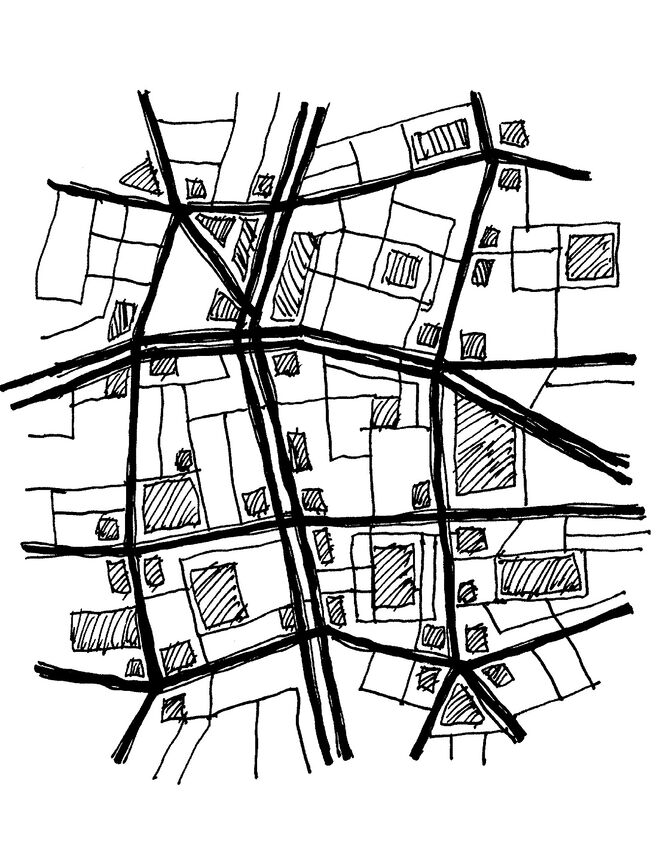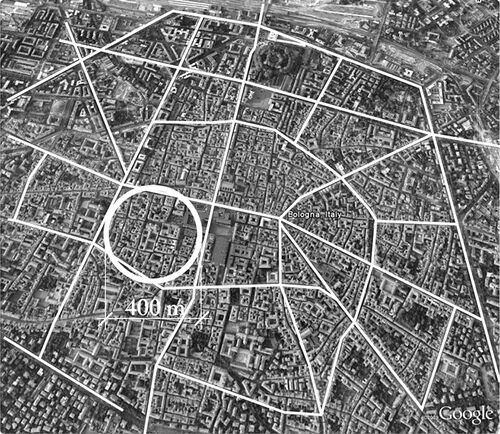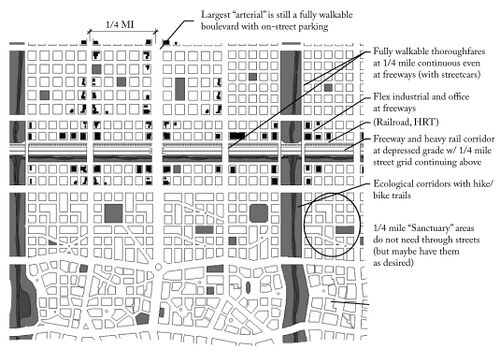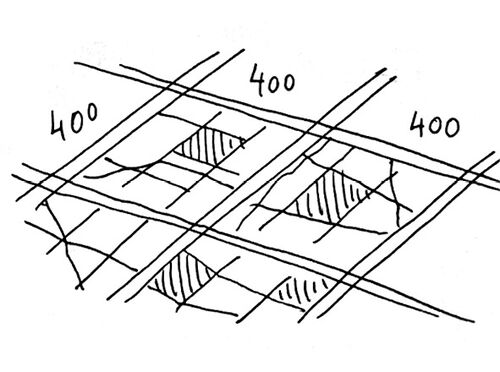1.4. 400M Through Street Network
Aus Pattern Language Wiki
(Weitergeleitet von .../400M Through Street Network)
Within a Polycentric Region, we need to establish a balance between vehicular mobility and pedestrian safety, while maintaining, as much as possible, a continuous connectivity through the urban region.
Problem-statement: At a larger urban scale, there is need for higher-speed vehicular mobility. But at a smaller sub-neighborhood scale, there is a need for resident-pedestrians to have a quieter area, free of the dangers and disruptions fast-moving vehicles.
Discussion:: In many cities around the world, there is a surprisingly consistent pattern of through vehicular streets, spaced at roughly 400 meters or ¼ mile, or less. This pattern long predates the automobile, a fact that is not so surprising when we consider that vehicles of various kinds (carts, carriages, etc.) have existed in cities for millennia, and that these vehicles all pose some dangers to pedestrians. It seems that neighborhoods have self-organized to achieve a balance between the needs for pedestrian protection and vehicular mobility, by creating a protective zone (or “sanctuary,” as described by Donald Appleyard) that is roughly equal to an easy walk, or slow drive, to the nearest vehicular street. That distance is about 200 meters, or 400 meters in diameter.¹
The same pattern can be seen in many other cities around the world.
It is important to understand that this pattern does not require a regular grid, or standard block sizes, although many cities (especially older cities in the United States) do in fact have the 400-meter pattern within a regular grid, and often with standard-sized blocks. The pattern also does not prohibit some smaller streets from aligning within these 400-meter zones or through their edges. It only requires that these smaller streets do not accommodate fast-moving vehicles, traveling relatively straight for long uninterrupted distances (typically 3 kilometers or 2 miles).
and a much more irregular pattern of principal through avenues at 400m (as shown below) is possible.
Therefore:
When laying out street grids, use a rough spacing of 400m (¼ mile) or less for principal through streets. Within these roughly 400m areas or “sanctuaries,” make shorter, interrupted, lane-like streets that accommodate vehicles, but allow pedestrians to dominate.
At larger scales, accommodate higher-speed mobility with the Multi-Way Boulevard that combines mobility with safe paths and crossings for pedestrians and bicycles. Where the highest speeds are required, use a Mobility Corridor with grade-separated pedestrian and bicycle paths, and crossings at no more than 400 meters. At smaller scales, use the Avenue and Shared Space Lane patterns…
¹ This concept was examined at length in Mehaffy M.W., Porta, S., Rofè, Y. and Salingaros, N. (2010), Urban nuclei and the geometry of streets: The ‘emergent neighborhoods’ model. Urban Design International, 15(1), 22-46.
Mehaffy, M. et al. (2020). 400M THROUGH STREET NETWORK (pattern). In A New Pattern Language for Growing Regions. The Dalles: Sustasis Press. Available at https://pattern-language.wiki/.../400M_Through_Street_Network
SECTION I:
PATTERNS OF SCALE
1. REGIONAL PATTERNS
Define the large-scale spatial organization…
1.4. 400M THROUGH STREET NETWORK
2. URBAN PATTERNS
Establish essential urban characteristics…
3. STREET PATTERNS
Identify and allocate street types…
4. NEIGHBORHOOD PATTERNS
Define neighborhood-scale elements…
5. SPECIAL USE PATTERNS
Integrate unique urban elements with care…
6. PUBLIC SPACE PATTERNS
Establish the character of the crucial public realm…
7. BLOCK AND PLOT PATTERNS
Lay out the detailed structure of property lines…
8. STREETSCAPE PATTERNS
Configure the street as a welcoming place…
9. BUILDING PATTERNS
Lay out appropriate urban buildings…
10. BUILDING EDGE PATTERNS
Create interior and exterior connectivity…
10.1. INDOOR-OUTDOOR AMBIGUITY
SECTION II:
PATTERNS OF MULTIPLE SCALE
11. GEOMETRIC PATTERNS
Build in coherent geometries at all scales…
11.2. SMALL GROUPS OF ELEMENTS
12. AFFORDANCE PATTERNS
Build in user capacity to shape the environment…
13. RETROFIT PATTERNS
Revitalize and improve existing urban assets …
14. INFORMAL GROWTH PATTERNS
Accommodate “bottom-up” urban growth…
15. CONSTRUCTION PATTERNS
Use the building process to enrich the result…
SECTION III:
PATTERNS OF PROCESS
16. IMPLEMENTATION TOOL PATTERNS
Use tools to achieve successful results…
16.2. ENTITLEMENT STREAMLINING
16.3. NEIGHBORHOOD PLANNING CENTER
17. PROJECT ECONOMICS PATTERNS
Create flows of money that support urban quality…
17.4. ECONOMIES OF PLACE AND DIFFERENTIATION
18. PLACE GOVERNANCE PATTERNS
Processes for making and managing places…
18.3. PUBLIC-PRIVATE PLACE MANAGEMENT
19. AFFORDABILITY PATTERNS
Build in affordability for all incomes…
19.1. INTEGRATED AFFORDABILITY
20. NEW TECHNOLOGY PATTERNS
Integrate new systems without damaging old ones…
20.2. RESPONSIVE TRANSPORTATION NETWORK COMPANY



